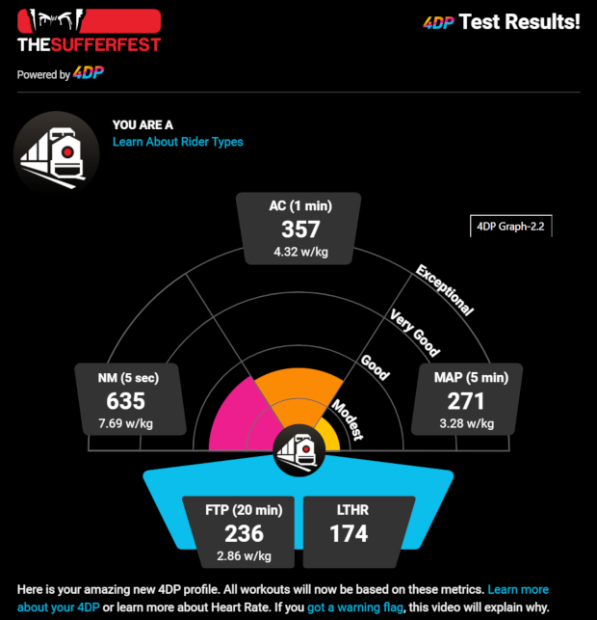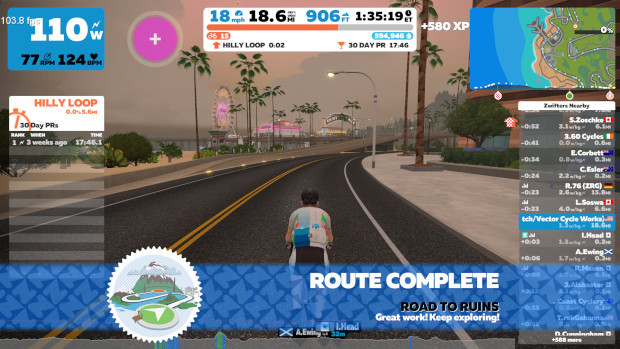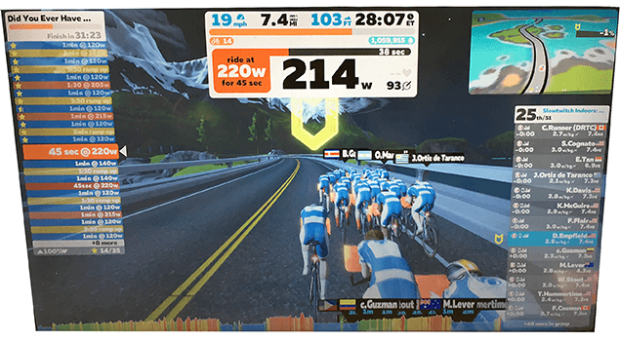SMART Indoor Training: You Are Here

In our first two installments of the SMART Indoor Training series, we discussed how we use measurement as a key element of defining our goals. SMART is an acronym for “Specific”, “Measureable”, “Attainable”, “Realistic”, and “Timely”, and we can leverage these concepts to set and meet our goals. You can catch up on the first two installments here:
SMART Indoor Training: How Do You Measure Up?
SMART Indoor Training: Setting Goals (Your "A" Race)
So far, we’ve started to form a game plan for a successful season – we’ve set our goals and started to think about how we can make goals that adhere to the SMART principles. With goals in mind, we can now start to shift our focus towards the tools that indoor training software platforms provide in order to support our goals. By honing in on the features that are most useful to you, you can settle on the best indoor training applications and hardware for you.
Today, we’re focused on establishing your baseline performance metric. We can gauge endurance sports performance in simplest terms as our ability to cover a distance over time – how long does it take you to run 5 km? How long does it take you to swim 100 meters? How long does it take for you to ride 40 km? These are measurements of pace that we’ve been doing for years (and don’t require a lot of special equipment), but they don’t tell the entire story. We can enhance those pace measurements by adding in additional biometric indicators such as heart rate, lactate threshold, sweat rate, or V02 max. Was that 20 minute 5k run your absolute best effort? Could you do that every weekend?
Outdoors, we have external factors – temperature, wind, hydration levels, sleep quality, time of day, road surfaces, traffic, etc. – that introduce variability to the aforementioned pace and biometric measurements and make it harder to get an apples-to-apples comparison of individual performances. Indoor training removes some of those variables – you have more control over an indoor environment that will lend itself to better comparisons over time. The room temperature is more constant, there isn’t any wind, and you can mount your bike in your trainer the same way every time. We can leverage indoor training for a SMARTer baseline – more Specific, more accurately Measurable, and potentially more Realistic.
Admittedly, we’re going to cater to the cyclists today – the major indoor training applications and hardware on the market have been cyclist-centric, for the most part. By nature, being coupled to a bicycle allows for additional measurement opportunities of a cyclist’s output – we can get power. That’s where we’re going to focus today: How can you measure your cycling power?
In physics, power is defined as the time-rate of doing work. It is generally measured in average watts over a period of time. In power-based training, we commonly use Functional Threshold Power (FTP), which is the average wattage that a person can sustain for 1 hour. FTP has become a common and popular means for cyclists to benchmark their fitness, as it makes for a relatively simple distillation of one’s output. But first, we need to arrive at your FTP. All of the major indoor cycling applications provide one or more methods of testing a rider’s FTP. FTP tests come in different shapes, so let’s look at our options.
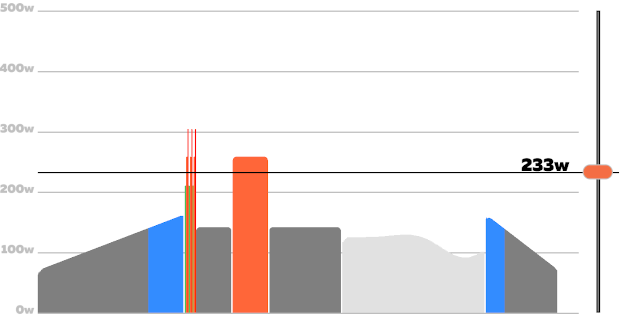
The Worst 20 Minutes of Your Cycling Life: The 20-Minute FTP Test
If there is one FTP test that could be described as the standard, it would be the 20-minute test. The construct is simple: warm up well, and then go really hard for 20 minutes. Take the average wattage for that 20 minutes, multiply it by .95, and you have a decent estimate of your FTP.
If you’ve never done an FTP test before or don’t have a lot of experience with power-based training, you might not know what “go really hard” is. I tend to describe it as “the worst 20 minutes of your cycling life.” This is why I’m not in Marketing… 20 minutes of feeling like your heart is going to explode is awful, especially if you have no idea how to pace yourself. The dichotomy of an FTP test is that you need to kind of have an idea of what your FTP is in order to have a target wattage. If you don’t know your FTP, where do you start?
For a cyclist who is new to power, a starting point might be to target an FTP equal to your bodyweight in pounds. If you weigh 150 pounds and are of at least average fitness, you could potentially target an FTP of 150. Of course, that would then mean that you would have to shoot for a bit more than that for your target wattage during the 20 minutes of the FTP test. Take your weight, divide by .95 and you’ll have a test target number. 150/.95 is equal to roughly 158. Pacing yourself for 20 minutes is mentally and physically hard and will take some practice. Start easy, and take it a minute at a time. If it doesn’t seem like you nailed it, that’s OK – FTP testing is something you’ll be doing somewhat regularly going forward, and you’ll get better at it.
Several of the major indoor cycling applications – Zwift, Rouvy, TrainerRoad, and others – offer a 20-minute FTP test built-in, but this is one that you can do on your own, if you have a power meter and a calculator.
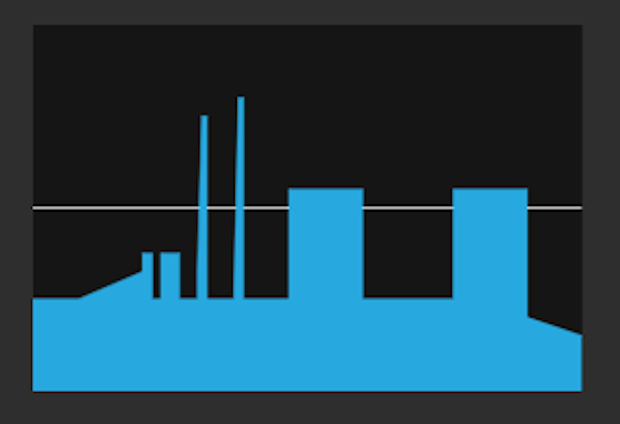
8 Minute FTP Test
The 20 minute FTP test can be very difficult to pace – riders new to it might go out too hard, while riders who have done it before might go out too easy and surge at the end. Because of this, the 8 Minute FTP test is offered as an alternative.
The protocol: warm up well, go really hard for 8 minutes, rest briefly, go really hard for another 8 minutes. Your FTP is the average of the two 8-minute blocks multiplied by .9. Compared to the 20-minute test, you are aiming for higher wattages during the two 8-minute intervals, but the shorter duration will be easier to pace. If you feel like you went too hard or not hard enough during the first interval, you get a chance to do better. TrainerRoad is the only major app to offer this option built-in, but you can also do this one manually with a power meter.
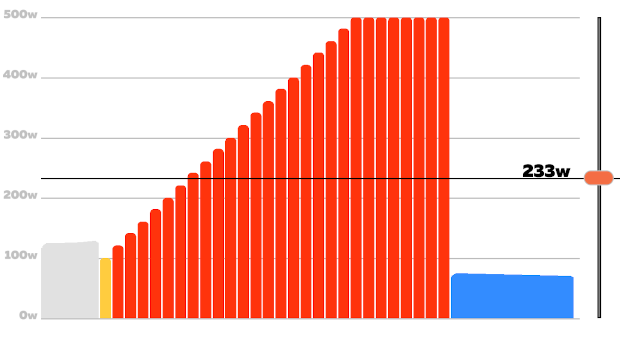
Ramp Test
Ramp testing has become popular in the last couple of years as a means to get a decent estimate of a rider’s FTP without the pacing challenges of the 20-minute FTP test. It’s meant to be a quicker and less painful test that will be easier to do more regularly.
The concept is simple: hold a target wattage for a minute, increase the target, hold that for a minute, and repeat until you can’t do it anymore. Once you have your best minute, you can then calculate your FTP by multiplying that by .75. TrainerRoad, Zwift, and The Sufferfest offer ramp tests.
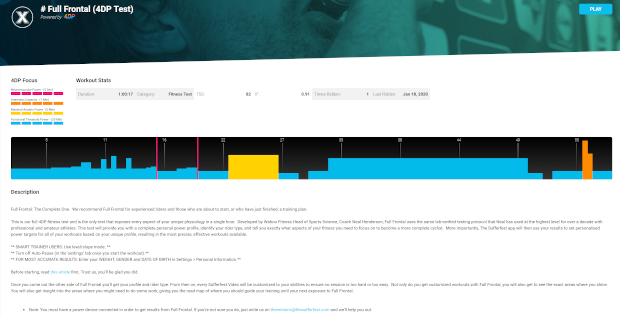
The Sufferfest’s Take on Power: 4DP
The Sufferfest hasn’t been mentioned much yet because they have their own take on FTP testing. They have two different FTP tests: a ramp test called the Half Monty, and a more comprehensive exam called Full Frontal. Full Frontal utilizes The Sufferfest’s 4DP concept, which measures more than just FTP – it looks to understand what kind of riding best suits you. Are you a sprinter? A climber? A time-trialer? Full Frontal will help you find out by utilizing (2) 15-second intervals, a 5-minute interval, a 20-minute interval, and a 1-minute interval, all in the span of an hour. Yeah, it’s brutal.
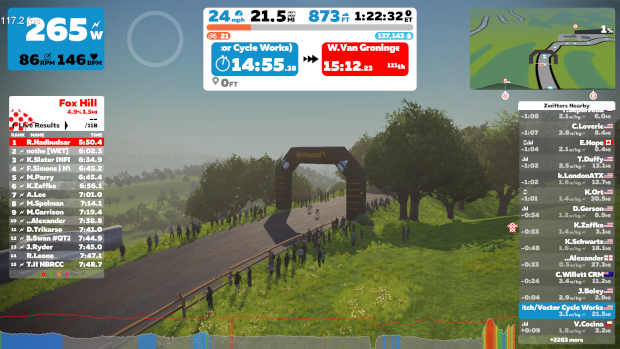
Dynamic FTP Testing: Just Ride
Finally, a couple of the major applications – TrainerRoad and Zwift – support a dynamic FTP measurement by simply riding. For example, if you join in a race in Zwift and put in a solid effor for an hour, you might get rewarded with a new suggested FTP. This is the easiest and most natural way to measure, and ideal for beginners who might not know where to start. Just do your thing!
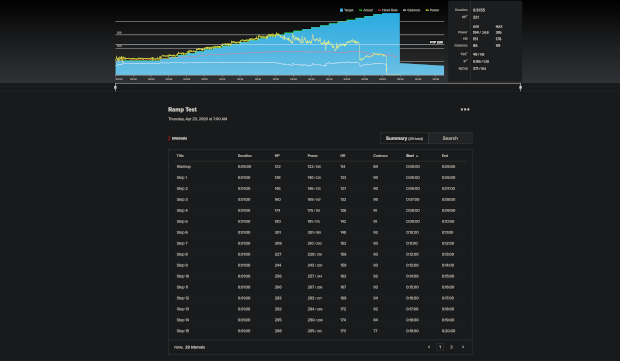
You Are Here.
Once you’ve performed your FTP test, you have your number. Your FTP is yours and yours only. If you’re bummed because your FTP isn’t as high as your group ride friend you’re always struggling to keep up with, that’s OK. If you’re perplexed because your FTP is higher than your group ride friend who you’re always struggling to keep up with, that’s OK, too. Group rides introduce a lot of external factors that we’ve stripped out of the equation for now.
With FTP, we now have a clear metric with which we can work. The next step is to use that number as a baseline for training over the near future. Leveraging training techniques that have been proven through years of practical application will help you make your number grow. We’ll delve into workouts and training plans in the next two installments of this series, looking at these as constructs of short-term and intermediate goals to raise your FTP to support your bigger goals.


